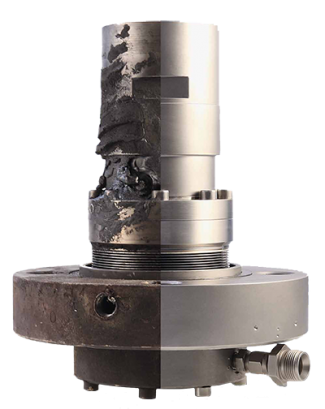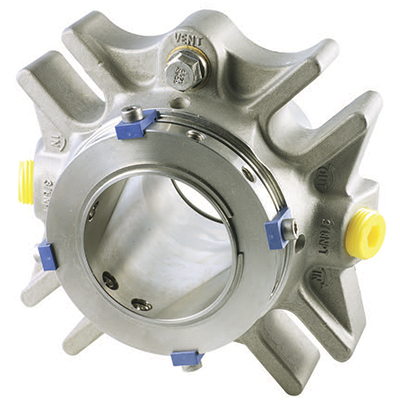Pumps are essential throughout the world. They are used to move all types of liquids in a wide variety of applications. Examples of industries where pumps are used are: Chemical & Pharmaceutical, Oil & Gas, Pulp & Paper, Power Generation, Water & Wastewater, Food & Beverage, Cosmetics, General Industrial, and much more.
Pump Seals and Mechanical Seals for Pumps
Seals are an integral part of any rotating equipment handling fluids. There are a wide a variety of seals as well depending on what the end-user of the equipment is looking to achieve based on a specific application. For the purposes of this article, we will be focusing on mechanical seals. There are several types and arrangements of mechanical seals. Single component seals and dual component seals, single cartridge seals, and dual cartridge seals. Depending on your specific application and operating conditions, one of these seal arrangements will likely be specified.
A dual seal, whether component or cartridge, will require a support system. This will likely consist of some type of barrier fluid system. A dual pressurized system is used to maintain a higher pressure than the seal chamber of the pump. A non-pressurized system is used to lubricate the seal faces but will not contaminate the system with barrier fluid should there be an inboard seal failure.
The mechanical seal on your pump is the weakest link in any given pump system. A good analogy would be like the circuit breaker in your electrical panel. If it pops, you know there is a problem in the system. Similarly, if your seal is starting to leak, there are likely other issues within the system that need attention. The sooner they are identified and attended to the better. A preventative maintenance program should be instituted as a best practice to keep your equipment in optimal working condition.
Here are some areas to observe that can often lead to failure in pump seals and mechanical seals:
Preventative Maintenance (PM) - Bearing Frame | Gland Gasket | Seal Sleeve / Shaft
As part of any PM program, it is essential to make regular checks of the equipment. Look at the equipment. Make sure you have the correct oil level in bearing frame and that the oil does not appear milky in color. This would indicate the oil is contaminated and lead to bearing issues. Do you notice any seal leakage? Try to take note where the leak is coming from. Is it the gland gasket? Between the gland and drive collar? Between the seal sleeve and shaft? Another good practice during PM checks is to check the level of barrier fluid in your dual seal support system. If you’re noticing a drop in the liquid level in the reservoir is an indication of an inboard seal leak. Determining the leaks origination will help to identify what components are compromised, i.e., gaskets, O-rings, or seal faces.
Look at Suction Pressure and Discharge Pressure Gauges
Is the pump running at the correct pressures as designed? High pressure can be caused by someone simply closing or not opening a valve, or possibly piping that is clogged downstream. This will lead to dead heading of the pump, which can exceed the pressure capability of the seal leading to seal failure. On the other end, a low net positive suction head (NPSH) can lead to pump cavitation, which can cause shaft deflection and lead to damaged seal faces and insufficient lubrication of the seal faces, ultimately resulting in seal failure.
Check Temperature Gauges
Is the reading higher than it should be? If there are excursions to a higher temperature than the limit of the elastomers chosen for the mechanical seal, this will lead to O-ring failure and seal leakage. Higher temperatures can also be caused by not having proper fluid exchange through the seal or seal chamber, such as inadequate lubrication, improper flush plan, etc.
Listen to the Pump
Is there a harmonic or vibration noticeable? This can cause bearing issues down the road. If the bearings fail, chances are the seal will too. Check the level and color of the oil in the bearing frame. Best practice: if you are doing a seal change, replace the bearings as well…you’ll be glad you took that extra step. Does the pump sound like it’s pumping rocks? This is typically what pump cavitation sounds like. If you do find such issues, immediately execute a more detailed inspection to see if it can be remedied. This can be caused by a loss or drop in NPSH, leak in the suction piping and if not remedied, this can lead to pump damage, total seal failure and unexpected down time and lost production.
Partner with a Seal Expert
Gallagher Fluid Seals would stress the need for a preventative maintenance program to maintain the overall health of your equipment. The earlier issues are found and attended to, will undoubtedly increase the meantime between repair or replacement of pumping equipment and mechanical seals. If you experience pump seal failure that does not appear to be attributed to the above issues, contact a mechanical seal professional to look at your equipment and assess the situation. Also, sending a mechanical seal to a mechanical seal professional for root cause failure analysis can be extremely helpful. It may uncover issues that are not overtly evident. In the hands of a professional, like Gallagher Fluid Seals and their partner EagleBurgmann, the damaged components of a pump seal or mechanical seal can tell an interesting story about what may be happening in your process.

This article was written by Lino D, Sales Engineer at Gallagher Fluid Seals.
For more information about mechanical seals, pump seals, or for seal failure analysis, contact Gallagher Fluid Seals.

